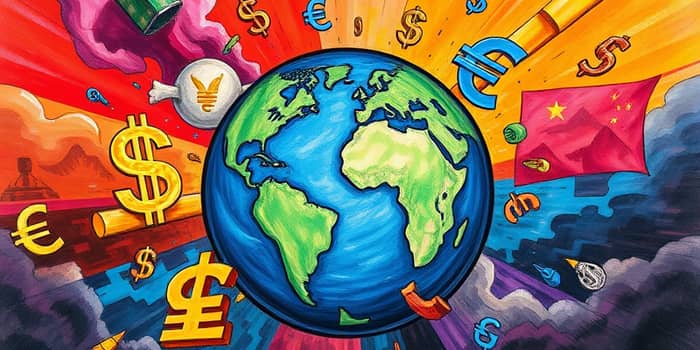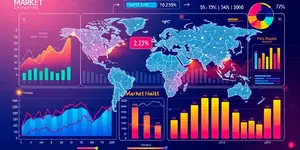
The balance of power in international markets often hinges on the relative value of currencies. When nations engage in strategic rate adjustments, the reverberations can reshape entire economies.
In this article, we explore how competitive advantage in international trade emerges from exchange rate maneuvers, tracing the historical arcs, policy instruments, and future pathways for cooperation.
At its core, a currency war involves deliberate currency devaluation to gain an edge over trading partners by making exports cheaper and imports more expensive.
An exchange rate denotes the price at which one currency can be exchanged for another. These rates either float freely under market forces or are held fixed by governments through official pegs.
The Foreign Exchange Market, commonly called Forex, is the global foreign exchange marketplace where banks, institutions, and speculators handle trillions of dollars in daily exchanges.
Floating regimes can absorb shocks but introduce volatility. In contrast, fixed pegs offer stability but require large reserves to defend against speculative attacks.
Consider a scenario where Country A deliberately weakens its currency. Its exporters suddenly enjoy lower costs abroad, while consumers at home face higher prices for imported goods.
For businesses, currency swings can complicate budgeting, inventory planning, and long-term contracts. Investors and tourists also feel the impact in yields and purchasing power.
In early 2024, data revealed that the United States imported over $35 billion of goods from China while exporting nearly $12 billion, a gap partly influenced by persistent differences in currency valuation.
Rapid swings in value can also lead to sudden stops in capital flows, as international investors seek refuge from unpredictable markets.
The Great Depression saw major economies, including the U.S. after the Gold Reserve Act of 1934, shift away from the gold standard to devalue their currencies and stimulate exports.
China’s 1994 yuan devaluation laid the foundation for decades of export-led growth, illustrating how exchange rate misalignments cause trade patterns to tilt heavily toward one major partner.
Japan’s 2010 yen intervention aimed at reversing deflation, though it risked sparking competitive responses from other central banks wary of export pressures.
The 1997 Asian Financial Crisis began with the Thai baht’s depreciation and cascaded through neighboring economies, highlighting the danger of sudden capital flight and the need for robust financial safeguards.
In recent years, tensions between the U.S. and China have underscored how currency policy can become a theatre in broader trade disputes, influencing tariffs, negotiations, and strategic alliances.
Governments deploy a mix of instruments to guide currency values. Direct market interventions involve buying or selling foreign reserves to nudge rates in the desired direction.
Adjustments to benchmark interest rates can attract or repel foreign capital. Higher rates tend to strengthen a currency by luring investment; lower rates can weaken it to boost exports.
However, these tools carry risks. Uncoordinated rate cuts can spark inflation, undermine long-term planning, and erode trust in central bank independence.
Research by UNCTAD shows that exchange rate misalignments cause about 1% of world trade to be diverted annually, redistributing economic activity rather than growing it.
Competitive devaluations tend to shave off 1-2 percentage points annually from worldwide trade growth, equating to hundreds of billions of dollars in lost output.
These losses translate to lower GDP growth, fewer jobs in export industries, and diminished innovation as firms face unpredictable revenue streams.
The International Monetary Fund has also documented how episodes of sharp currency fluctuation coincide with global trade contractions and efficiency setbacks.
Repeated interventions without clear policy frameworks weaken the credibility of central banks. Markets may start to anticipate rate moves, leading to speculative attacks and greater volatility.
Contagion risk means that a crisis in one nation can propagate through banking linkages and capital flows, as seen during the Asian Financial Crisis and the 2008 global downturn.
Political interference in monetary policy, like in Turkey where rate cuts were favored despite high inflation, can lead to sustained currency depreciation and loss of investor confidence.
Ultimately, currency stability and fair trade conditions are best maintained through multilateral cooperation and policy coordination among major economies.
International institutions such as the IMF and World Trade Organization can monitor rate levels, offer policy advice, and facilitate dialogue to minimize competitive devaluations.
Multilateral frameworks help prevent beggar-thy-neighbor actions, ensuring that no country gains at the expense of collective economic health.
Coordinated action can also reduce the temptation for protectionist measures, preserving the benefits of an open global trading system.
While currency wars may offer temporary boosts in trade performance, the long-term consequences—from eroded trust to financial instability—are too steep to ignore.
By choosing cooperation over competition, nations can secure more predictable exchange rate environments, foster robust trade growth, and build resilience against future shocks.
In an era where supply chains and markets interlink across continents, a balanced approach to currency policy paves the way for sustainable and inclusive prosperity.
References













